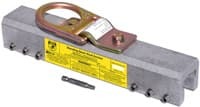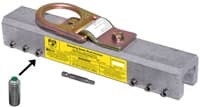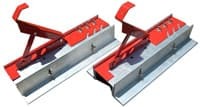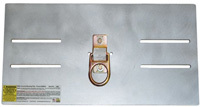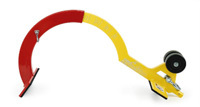Fall Protection Strategies For Metal Central H-Loc Roofs
Posted by Howie Scarboro - CEO Fall Protection Distributors, LLC on Jun 3rd 2025
See the Roof Anchor Compatibility Chart for Metal Central Standing Seam Panels.

Who Is Metal Central?
Metal Central is a trusted regional supplier of metal roofing, siding, and building systems. It offers nationwide quality with a local touch.
Headquartered in Lowell, Arkansas, Metal Central provides contractors across the Southeast and Midwest with reliable access to various metal products, including metal panels, building kits, gutters, trim, and other related items. Known for pairing big-name manufacturing from Central States Manufacturing with personal, hands-on customer service, Metal Central is the go-to resource for residential, commercial, and agricultural builders.
Their network of retail locations—spanning Alabama, Arkansas, Kentucky, Missouri, Pennsylvania, and Texas—gives contractors a fast, local option for everything from roof panels to fully engineered metal buildings. What sets them apart is their attention to detail, quick turnaround times, and contractor-friendly services, including job site delivery, takeoffs, and in-house estimating. Whether you're building a backyard barn or a 10,000-square-foot warehouse, Metal Central has the components—and the know-how—to get the job done right.

Why Are Compatible Fall Protection Products Critical for Standing Seam Roof Systems?
Not all fall protection systems are suitable for standing seam metal roofs—using the wrong anchors can void warranties, damage panels, and create serious safety risks.
Standing seam roofs shed water, resist uplift, and offer long-lasting performance—but they also present a challenge when anchoring fall protection. Unlike shingle roofs or screw-down panels, standing seam systems rely on floating or concealed clips and interlocking seams, which means that traditional screw-in anchors aren't only ineffective but can compromise the roof's structural integrity. The wrong anchor can crush seams, create permanent leak points, or even void the roof's manufacturer warranty.
That's why using compatible, non-penetrating fall protection systems—like seam-mounted anchors that clamp without piercing the panel—is critical for protecting your crew and the roof beneath them. By selecting the appropriate safety equipment, contractors can ensure OSHA compliance, minimize liability, and guarantee that their metal roofing system performs as intended for years.
Horizon-Loc Panels

The Horizon-Loc panel offers the clean look of standing seam roofing at a more affordable price. It features hidden fasteners and a simple snap-together installation process.
See the Roof Anchor Compatibility Chart for Metal Central Horizon-Loc Standing Seam Panels.
Horizon-Loc, also known as H-Loc, is Metal Central's most popular concealed fastener roofing panel, offering the sleek aesthetic of standing seam roofing without the need for mechanical seaming tools. Manufactured by the Central States, this snap-lock panel is 16-inch wide with a 1-inch seam height and is available in 24 and 26-gauge steel. It installs over solid decking with underlayment, such as 30-lb. felt paper or equivalent, and does not require hand-seaming—making it faster and more affordable to install than traditional mechanically seamed panels.
The panel finish is AZ50 painted Galvalume or AZ55 acrylic-coated Galvalume and is available in a range of SMP and CentralGuard Kynar finishes. Horizon-Loc panels are tested to UL 2218 for Class 4 impact resistance and UL 790 for Class A fire resistance and carry approvals for the Texas Windstorm and Florida building codes. With a recommended minimum roof slope of 3:12, Horizon-Loc is a reliable choice for residential and light commercial projects that seek the benefits of a standing seam without the complexity or cost.
Fall Protection For Horizon-Loc Panels
Only the 24-gauge version of Horizon-Loc is compatible with SSRA1 Seam Anchors and related accessories. At the same time, 26-gauge roofs require alternative tie-off methods.
When working on 24 gauge Horizon-Loc panels, roofers can access a complete system of non-penetrating fall protection products that mount directly to the seam without compromising the roof's structural integrity or warranty. The foundation of this system is the SSRA1 Seam Anchor, which clamps securely to the 1-inch snap-lock seam using cupped tip set screws that won't damage the metal panel. Once installed, this anchor provides a 5,000-pound certified tie-off point for a single worker in either fall arrest or fall restraint mode.
For increased functionality on larger or more complex projects, the SSRA2 Adjustable Roof Jack Adapter mounts on top of the SSRA1 anchor, allowing contractors to install 2x10 wooden walkboards between anchor points. These walkboards provide a safe and stable working surface on sloped metal roofs, making it easier to transport tools, access materials, or perform tasks such as panel installation, seam sealing, and trim work—all while staying OSHA-compliant.
Workers can further expand the system with the SSRA3 Anchor Plate, which also mounts onto the SSRA1 anchor base. The SSRA3 features two integrated D-ring connection points, allowing for the installation of a temporary horizontal lifeline system up to 100-feet in length. This feature enables multiple workers to move safely along the roofline while staying tied to a shared lifeline, ideal for larger crews, roof replacements, or multi-day projects.
For jobs that require long-term access or routine maintenance, the Super Anchor 120-foot Standing Seam Permanent Horizontal Lifeline Kit is an ideal solution. This all-in-one system includes SSRA-compatible seam anchors, shock absorbers, stainless steel cable, cable guides, and turnbuckles for tensioning—everything needed to create a permanent fall arrest system that doesn't penetrate the roof panels. It's ideal for commercial buildings, warehouses, and other structures where ongoing tie-off access is necessary.
In addition to seam-mounted solutions, workers can also use the Ridge Pro Steep Assist Anchor with 24 gauge Horizon-Loc panels. The Ridge Pro hooks securely over the ridge cap without fasteners, allowing workers to safely transition from the ladder to the roof and maintain 100% tie-off while moving across the ridge or performing work on steeper slopes (between 6/12 and 12/12). It's beneficial during inspection, cleaning, and light repair tasks when other anchors are not feasible.
Together, this group of products provides 24-gauge Horizon-Loc roofs with one of the most comprehensive and noninvasive fall protection systems available. It combines safety, versatility, and full OSHA compliance without damaging the roof.
For 26 gauge Horizon-Loc panels, the Ridge Pro Steep Assist Anchor is the safest and most compatible solution on slopes between 6/12 and 12/12.
Since seam-mounted anchors are not suitable for the thinner 26 gauge version of Horizon-Loc, we recommend using the Ridge Pro Steep Assist Anchor for steep slope access. The Ridge Pro hooks securely over the roof's ridge. It provides a secure tie-off point for working safely along the roofline. It's an ideal solution for inspections, repairs, and quick jobs where you still need 100% tie-off compliance without risking damage to the panel seams.
Metal Roof Anchor Panel Compatibility For Metal Central
| Horizon-Loc Panel 24 Gauge |
|
|---|---|
| YES | |
| YES | |
| YES | |
| YES | |
| YES |
Contact Us For More Information
For further details on roofing solutions and fall protection systems, please contact us at 863-703-4522 or visit www.StandingSeamRoofAnchor.com. Let's work together to make your roofing projects safe, beautiful, and built to last. For more safety tips, refer to OSHA's 48-page Fall Protection Manual. Once you have determined the most suitable anchors for your roof system, download our free Anchor Inspection Form.
Safety Tips For Standing Seam Roofs
Equip Workers with High-Quality Safety Gear
Reliable fall protection starts with the gear workers trust to save their lives. Harnesses, lifelines, and lanyards should meet OSHA regulations and be rugged, comfortable, and properly fitted. When gear feels right and works without fuss, roofers are far more likely to wear it correctly every time they step onto the roof.
Use Specialized Anchor Systems for Standing Seam Roofs
Installing anchors incompatible with standing seam roofing can lead to costly mistakes. Penetrating systems may violate warranties and compromise roof integrity. Instead, use seam-mounted anchors that clamp securely without drilling. These specialized solutions protect workers and the roof, offering OSHA-compliant fall protection with zero damage.
Promote a Culture of Safety
You can't mandate awareness—but you can lead by example. A strong safety culture encourages crews to speak up, look out for one another, and treat safety as part of every task, not just during the morning huddle. When workers see that safety isn't optional—it's standard—attitudes shift, and outcomes improve.
Prioritize Ladder Safety Training
Most falls don't start on the roof—they start on the way there. Training your team on proper ladder selection, securing the base, and maintaining three points of contact can prevent the most common access-related injuries. Reinforce the 4-to-1 ratio rule and inspect every ladder before use. Safety begins at ground level.
Encourage the Use of Trauma Straps
Without trauma straps, a suspended worker risks circulation loss, unconsciousness, and even death. These small, affordable add-ons let the worker relieve pressure from their harness and allow them to wait for rescue safely. Every harness should include them—no exceptions.
Ensure Proper Footwear for Stability
Generic work boots won't cut it on steep metal roofs. Roofing-specific footwear with grippy soles and solid ankle support provides traction where it's needed most. Whether the panels are dusty, wet, or icy, the proper boots make every step safer—and help prevent minor slips from becoming central falls.
Develop OSHA-Compliant Safety Plans
Safety plans aren't just paperwork—they're proactive protection. Each site requires a customized blueprint that outlines hazards, emergency procedures, and workers' responsibilities. Review and refine it regularly. A solid plan enables your team to work smarter and respond more effectively to unexpected events.
Install Permanent Roof Anchor Systems
If you frequently revisit a roof—such as in commercial buildings, schools, or apartment complexes—a permanent anchor system pays off quickly. These fixed tie-off points eliminate the need for repeated setups, allowing workers to hook in immediately and saving time while improving safety for years.
Set Up Protective Guardrail Barriers for Work Zones
Visual cues alone aren't enough near roof edges. Temporary or permanent guardrails create defined zones that prevent accidental trips into danger. They're especially effective around skylights, access points, or wide-open commercial roofs. Guardrails let crews work with confidence and reduced exposure.
Consult Experts for Curved Metal Panels
Curved panels aren't just a design statement but a challenge for standard fall protection gear. Seam anchors may not sit flush, and the pitch can complicate tie-off angles. Before rigging anything, have a trained fall protection professional evaluate the site and specify solutions that won't jeopardize safety or roof performance.
Disclaimer
The views, recommendations, and information presented in this blog are solely those of the author and do not necessarily reflect the opinions or positions of the featured panel manufacturer, its brands, subsidiaries, or parent companies. Customers are strongly encouraged to contact the roof panel manufacturer directly for inquiries regarding fall protection compatibility with their products and to address any potential warranty issues arising after installing our products.


